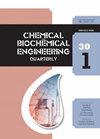考虑吸热效应的二维物体耗散微极流和传热的同伦模拟
IF 0.9
4区 生物学
Q4 BIOTECHNOLOGY & APPLIED MICROBIOLOGY
引用次数: 8
摘要
楔形的非牛顿流构成了化学工程系统中的一个基本问题,并与聚合物、涂层系统等的加工有关。在此基础上,采用同伦分析方法(HAM)对二维体(楔体)不可压缩微极流体的热对流边界层流动进行了半解析求解。粘性耗散和热沉效应包括在内。通过适当的坐标变换,将无量纲边值问题转化为一个非线性耦合常微分方程组。详细阐述了所谓的福克纳-斯坎流案例。用较早的简单模型以及一般模型的Nakamura有限差分法验证了HAM解。所采用的微极性模型相当准确地模拟了某些聚合物溶液,并具有微元素的旋转运动。考虑涡旋粘度参数(微极性流变)、Eckert数(粘性耗散)、Falkner-Skan(压力梯度)参数、微惯性密度和热沉参数的影响,计算了主、次剪切应力、壁面耦合应力、努塞尔数、微旋转速度和温度。本文还讨论了Blasius流和滞止流的特殊情况。研究发现,随着楔形参数和壁面吸热效应的增大,温度和热边界层厚度均受到抑制,这有利于聚合物涂层动力学中的温度调节。随着涡旋粘度的增加,微旋转过程中会产生较强的反向自旋,导致角动量边界层厚度增加。随着楔形参数的增大,初级和次级摩擦分量均减小。随着楔形参数的增大,Nusselt数也显著增加。本文章由计算机程序翻译,如有差异,请以英文原文为准。
Homotopy Simulation of Dissipative Micropolar Flow and Heat Transfer from a Two-Dimensional Body with Heat Sink Effect
Non-Newtonian flow from a wedge constitutes a fundamental problem in chemical engineering systems and is relevant to processing of polymers, coating systems, etc. Motivated by such applications, the homotopy analysis method (HAM) was employed to obtain semi-analytical solutions for thermal convection boundary layer flow of incompressible micropolar fluid from a two-dimensional body (wedge). Viscous dissipation and heat sink effects were included. The non-dimensional boundary value problem emerges as a system of nonlinear coupled ordinary differential equations, by virtue of suitable coordinate transformations. The so-called Falkner-Skan flow cases are elaborated. Validation of the HAM solutions was achieved with earlier simpler models, as well as with a Nakamura finite difference method for the general model. The micropolar model employed simulates certain polymeric solutions quite accurately, and features rotary motions of micro-elements. Primary and secondary shear stress, wall couple stress, Nusselt number, microrotation velocity, and temperature were computed for the effect of vortex viscosity parameter (micropolar rheological), Eckert number (viscous dissipation), Falkner-Skan (pressure gradient) parameter, micro-inertia density, and heat sink parameter. The special cases of Blasius and stagnation flow were also addressed. It was observed from the study that the temperature and thermal boundary layer thickness are both suppressed with increasing wedge parameter and wall heat sink effect, which is beneficial to temperature regulation in polymer coating dynamics. Further, strong reverse spin was generated in the microrotation with increasing vortex viscosity, which resulted in increase in angular momentum boundary layer thickness. Also, both primary and secondary skin friction components were reduced with increasing wedge parameter. Nusselt number was also enhanced substantially with greater wedge parameter.
求助全文
通过发布文献求助,成功后即可免费获取论文全文。
去求助
来源期刊
CiteScore
2.70
自引率
6.70%
发文量
23
审稿时长
>12 weeks
期刊介绍:
The journal provides an international forum for presentation of original papers, reviews and discussions on the latest developments in chemical and biochemical engineering. The scope of the journal is wide and no limitation except relevance to chemical and biochemical engineering is required.
The criteria for the acceptance of papers are originality, quality of work and clarity of style. All papers are subject to reviewing by at least two international experts (blind peer review).
The language of the journal is English. Final versions of the manuscripts are subject to metric (SI units and IUPAC recommendations) and English language reviewing.
Editor and Editorial board make the final decision about acceptance of a manuscript.
Page charges are excluded.

 求助内容:
求助内容: 应助结果提醒方式:
应助结果提醒方式:


